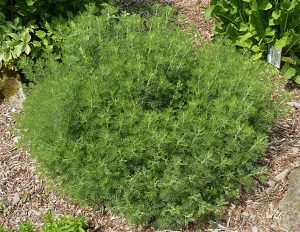 Also known as Old Man, Lad’s Love and Maiden’s Ruin, this bushy sub-shrub is native to southern Europe, parts of Asia, and Africa and is a member of the aster family, Asteraceae, that also includes sunflowers, daisies, and lettuce. The plant has erect branching stems and finely divided gray-green leaves that are 1.5 to 2.5 inches long and have a pungent camphor fragrance. The small dull yellow nodding flowers are carried in loose panicles and appear in the late summer but are not ornamentally interesting. Southernwood has a long history of use in medicine and cooking, and as a strewing herb and insect repellent but in more modern times it is grown for it attractive appearance and the fragrance of its foliage so is suitable for both the herb garden and perennial border. It is especially nice when planted near a bench or path where the foliage can be touched to give off its fragrance. Southernwood tolerates drought, poor soil, and hard pruning but is intolerant of humidity. Thriving in full sun and dry sandy soil, it can tolerate some shade but will die in damp shade. It can be used as an informal hedge or trimmed back hard and used as a formal edger. The genus name, Artemisia, honors the Greek goddess of chastity, the hunt, and the moon. The specific epithet, abrotanum, is the ancient Latin name for the plant.
Also known as Old Man, Lad’s Love and Maiden’s Ruin, this bushy sub-shrub is native to southern Europe, parts of Asia, and Africa and is a member of the aster family, Asteraceae, that also includes sunflowers, daisies, and lettuce. The plant has erect branching stems and finely divided gray-green leaves that are 1.5 to 2.5 inches long and have a pungent camphor fragrance. The small dull yellow nodding flowers are carried in loose panicles and appear in the late summer but are not ornamentally interesting. Southernwood has a long history of use in medicine and cooking, and as a strewing herb and insect repellent but in more modern times it is grown for it attractive appearance and the fragrance of its foliage so is suitable for both the herb garden and perennial border. It is especially nice when planted near a bench or path where the foliage can be touched to give off its fragrance. Southernwood tolerates drought, poor soil, and hard pruning but is intolerant of humidity. Thriving in full sun and dry sandy soil, it can tolerate some shade but will die in damp shade. It can be used as an informal hedge or trimmed back hard and used as a formal edger. The genus name, Artemisia, honors the Greek goddess of chastity, the hunt, and the moon. The specific epithet, abrotanum, is the ancient Latin name for the plant.
Type: Sub-shrub
Bloom: Small dull yellow flowers in late summer; not ornamentally interesting
Size: 3-4’ H x 18” W
Light: Full sun
Soil: Lean to average, moderately moist to dry, well-drained ; drought resistant
Hardiness: Zones 5-8
Care: Prune back hard in spring and early summer to maintain attractiveness.
Pests and Diseases: None of significance
Propagation: Semi-hardwood cuttings in late summer, root division, seed
Companion plants: Rosemary, lavender, sage, santolina, yucca, ornamental grasses, lamb’s ear, autumn crocus, aster ‘Purple Dome’, Mother-of-thyme
Photo Credit -Jamain-Wikimedia-Commons.